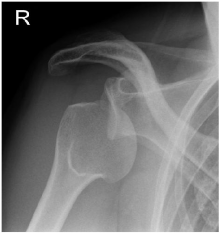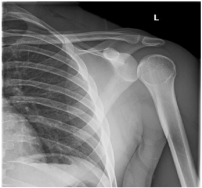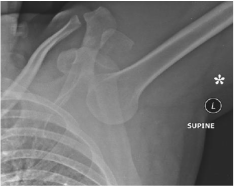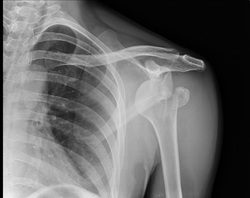Assessment and management of proximal humerus dislocations
by Toby Baring
Figure 2: Posterior dislocation of the shoulder - internal rotation of the head looks gives it a symmetrical appearance also known as the "light bulb" sign
|
History/mechanism
Anterior
Assessment Full neurovascular assessment of the effected arm Rule out concurrent injuries (e.g. brachial plexus/vascular/cervical) Investigations To determine direction of dislocation and extent of bony injury
|
|
Management
Anterior dislocation
- If simple dislocation or isloated avulsion of greater tuberosity (GT), attempt reduction with analgesia and sedation (ideally by anaesthetics)
- If complex fracture dislocation make arrangements for patient to go to next available theatre session during daylight hours with upper limb specialist. Consent for closed reduction +/- open reduction +/- fracture fixation +/-hemiarthroplasty.
Anterior dislocation
- Kocher’s tractionless maneuver
- Hippocratic technique
- Abduction and external rotation
- Hippocratic technique
If reduction successful
If reduction unsuccessful
- Place in a neutral rotation brace ideally (particularly if a fracture of the GT has anatomically reduced)
- Posterior dislocation - neutral rotation brace is obligatory (simple sling may cause re-dislocation)
- Re-assess neurovascular status of arm
- Repeat x-ray – two orthogonal views
- Refer to upper limb fracture clinic – to be seen within 1 week
If reduction unsuccessful
- Make arrangements for patient to go to next available theatre session during daylight hours. Consent for closed +/- open reduction
- In the case of a fractured GT if the shoulder reduces but the GT remains >5mm displaced discuss with an upper limb specialist within 48hrs
|
Further comments/pitfalls/exceptions
|
|




